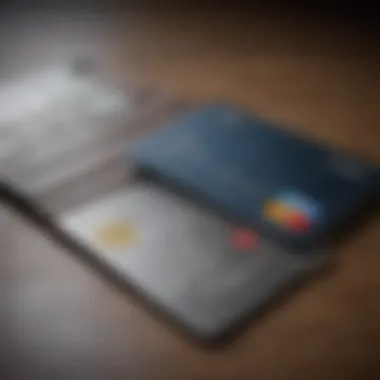Retrieve Your Credit Card Number Without the Card


Intro
In the modern financial landscape, the ability to access information about your finances without the physical card can be essential. Whether it's through online banking portals, mobile applications, or customer service assistance, understanding how to retrieve your credit card number plays a crucial role in financial management. This guide will examine the various methods available, highlighting their security implications and legality.
Understanding how to access your credit card number without the card itself involves using technology responsibly and ethically. This discussion will offer practical strategies that consumers can employ while navigating an increasingly digitalized financial world.
Digital Banking and Online Management
There are a few methods that consumers have for retrieving a credit card number without having the physical card. With advancements in digital banking, many institutions have developed systems that allow users to manage their accounts without needing to have their card on hand.
- Online Banking Portals: Many banks offer online portals that allow customers to log in and access their account information. After logging in, one can usually view their credit card details securely.
- Mobile Banking Applications: Similar to online banking portals, mobile applications provide an accessible way to view account details, including card numbers. Users must ensure these applications are secure and downloaded from reputable sources.
- Customer Service Assistance: If online options are insufficient or if more personalized help is needed, contacting customer service can be effective. Having personal information ready for verification is important to gain access to account details.
Access Security
When retrieving credit card information, it is vital to keep security in mind. Users should consider the following points:
- Two-Factor Authentication: Using two-factor authentication strengthens online accounts by requiring additional verification.
- Secure Connections: Ensure you are using secure and private internet connections when accessing sensitive information.
- Regular Monitoring: Regularly check account activity to identify any unauthorized transactions or anomalies.
Implications of Lack of Physical Access
Not having a physical card can raise concerns regarding security and accessibility. The reliance on digital access opens avenues for potential fraud, making it vital for consumers to act responsibly. Protecting personal information and using the methods mentioned above cautiously can reduce risks significantly.
The Role of Ethical Practices
Understanding how to retrieve your credit card number ethically is crucial. Engaging in deceptive practices, such as phishing or unauthorized access to others’ information, can lead to serious consequences. Consumers should always adhere to legal guidelines and engage in practices that promote transparency and security in financial dealings.
Prolusion to Digital Banking
Digital banking has transformed how individuals manage their finances. This transformation makes retrieving financial information more accessible than ever before, including how to find a credit card number without the physical card. Digital banking encompasses several platforms, allowing users to control finances through computers and mobile devices. The ability to access financial data on-demand has significant implications for consumers.
In essence, digital banking simplifies many aspects of financial management. Consumers can review account balances, monitor spending habits, and pay bills with just a few taps. This convenience extends to locating critical information, such as credit card numbers. However, it raises certain considerations that must be understood.
The rise of digital banking is not just about convenience; it's about empowerment. Users enjoy more control over their financial lives, which is especially important when it comes to securely managing sensitive data. With digital tools at their disposal, consumers can navigate financial landscapes more effectively. Still, they must remain vigilant about security and privacy, as the digital environment can expose them to various threats.
The Evolution of Financial Management
Financial management has evolved over centuries, adapting to advancements in technology and changes in consumer needs. From traditional ledgers to digital spreadsheets, each stage in this evolution has simplified financial processes. The latest phase, characterized by digital banking, emphasizes immediacy and convenience.
Institutional banking was once the only way to manage finances, requiring in-person visits. Today, customers can open accounts, transfer money, and acquire credit cards online. This shift mirrors societal changes, reflecting the need for more accessible and efficient financial solutions.
Impacts of Technology on Personal Finance
Technology has drastically affected how individuals manage their finances. Mobile applications and online platforms allow users to have instant visibility into their spending and savings. This accessibility not only makes financial management easier but also fosters better financial habits among users.
Many people can now track their expenses in real time, providing greater insights into their financial health. Furthermore, the ability to access credit card numbers and other sensitive information through digital banking means that financial transactions can occur swiftly—transforming traditional methods into efficient processes. However, these advancements come with challenges, including the risk of overspending and the imperative to protect against identity theft.
The integration of technology into personal finance represents both an opportunity and a challenge. Users must embrace the benefits of this digital age while remaining aware of potential risks. As they navigate this landscape, understanding the right methods for retrieving financial information, such as credit card numbers, becomes increasingly essential.
Understanding Credit Card Numbers
Understanding credit card numbers is crucial when discussing methods to retrieve them without the physical card. Consumers often face situations where they need their card details but do not have the card in hand. This knowledge not only helps in identifying the card for transactions but also assists in understanding the structure and security features inherent in credit cards.
In this section, we will explore the structure of a credit card number and the significance of each digit it contains. This foundational knowledge is vital for anyone looking to manage their finances electronically, as well as to protect their information more effectively.
Structure of a Credit Card Number
A credit card number typically consists of 16 digits arranged in a specific manner. However, the exact length can vary depending on the card issuer. For example, American Express card numbers are usually 15 digits long, while Visa, MasterCard, and Discover typically use 16 digits. The structure is not arbitrary; it follows a specific format that serves both identification and security purposes.


The first digit of a credit card number indicates the card network. Here are some common examples:
- Visa cards start with a 4.
- MasterCard cards begin with a number between 51 and 55 or with a 2.
- American Express starts with a 34 or 37.
The next several digits, typically six, identify the issuing bank. These digits are followed by a series identifiable only by the consumers and the bank, often termed the account number. The last digit is known as the check digit, which is used for validation purposes through an algorithm called the Luhn algorithm. Each section serves a distinct purpose, and understanding this can be important during any card-related transactions.
Significance of Each Digit
Every digit in a credit card number carries specific significance. The first digit provides information about the card network, which helps businesses and merchants quickly identify the card type and network processing that will occur. The following sequence of digits reveals the issuer and, consequently, the background of the cardholder. This assists in battling fraud and improper use of the card.
- First digit: Card network identifier.
- Next six digits: Issuer identification number, pinpointing the bank that issued the card.
- Next numbers: Unique identifier for the account, associated with the cardholder.
- Last digit: Check digit for verification.
This structured digit arrangement contributes to ensuring security and efficiency in transactions. Understanding how these numbers work enables consumers to better navigate their financial management and adds an essential layer of awareness regarding their privacy and card safety.
It is important to keep your credit card number and related information secure while understanding its structure and significance for effective financial management.
With this understanding, readers can proceed to explore methods for retrieving their credit card numbers, highlighting the relevance of digital interactions in today's financial landscape.
Methods to Access Your Credit Card Number
Accessing your credit card number without the physical card can be crucial when dealing with online transactions or subscriptions. Knowing the methods to retrieve this information is important for many users. Most people today rely on technology for various aspects of their financial lives, making remote access necessary. Understanding how to access your credit card number can save time and reduce stress.
Using Online Banking Portals
Utilizing online banking portals is one of the most effective methods to find your credit card number. These platforms provide a centralized hub for managing your finances online. The convenience of logging in from anywhere is a standout feature. Most banks invest in security measures to protect your data during this process. Therefore, it is generally safe.
Steps to Log into Your Banking Account
To begin the retrieval process, you must first log into your online banking account. This step involves navigating to your bank's website and entering your login credentials.
- Visit the official website of your bank.
- Locate the login section, usually found on the upper right corner.
- Enter your username and password. Some banks may require additional authentication.
- Once logged in, access your account dashboard.
This process is straightforward and allows users immediate access to their financial data. A key characteristic is the enhancement in security features, like two-factor authentication. This extra layer of security is beneficial as it protects your sensitive information from unauthorized access.
How to Locate Your Card Number
Once logged in, the next step is to locate the credit card number. This process can usually be done within your account dashboard. Look for sections labeled 'Accounts' or 'Cards.'
The interface design of most online banking portals is user-friendly. Each bank may display information differently, but the essential function remains the same. This capability is favored, as it provides instant access to important data without requiring a physical card.
Mobile Banking Applications
Mobile banking applications also play a significant role in retrieving your credit card number. With the advancement of technology, these apps have become increasingly sophisticated.
Features of Banking Apps
Banking apps offer a diverse range of features, allowing users to manage their finances efficiently. The ability to access financial information on-the-go stands out prominently. Many of these applications include biometric logins, bill payments, and transaction monitoring.
The unique feature of accessing your credit card number through a mobile app lies in its portability. You can manage your finances anywhere and at any time. This convenience is important in today’s fast-paced world.
Retrieving Information from Mobile Apps
To retrieve your credit card number from a banking app, simply follow these steps once you have logged in:
- Navigate to your accounts or cards section.
- Select the credit card in question.
- View your card details, which might include the card number.
Again, security is often emphasized. Most apps integrate strong encryption methods. However, it is essential to ensure you are using the official app to avoid risks.


Contacting Customer Service
In some situations, contacting customer service may be necessary. If you encounter difficulties, customer service can assist you directly in retrieving your information.
What Information You May Need
When preparing to contact customer service, gather essential information that may be required. This typically includes personal identification details such as your name, date of birth, and account number. Having this information ready can expedite the process. Collecting specific details is necessary to meet the customer service representative's requirements, allowing for more effective assistance.
Understanding the Verification Process
Customer service will conduct a verification process to confirm your identity. This process is essential to maintain account security. Various methods may be employed, such as answering security questions or providing identification.
This verification is beneficial as it protects your account from unauthorized access. However, it can also be seen as a downside due to the time it may consume.
Account Statements and Documents
Sometimes, older methods may still be useful. Physical documents like account statements can contain your credit card number. Learning how to read these statements will allow access to your information.
How to Read Your Statements
Your account statements summarize financial activity for a certain period. They typically include your credit card number somewhere near your transaction details. Familiarize yourself with the structure of these documents, where the card number is usually presented clearly.
The effectiveness of reading your statements lies in having access to tangible records. However, it requires knowing how these documents are organized to find what you need quickly.
Finding Your Card Number in Physical Documents
If you have physical statements at hand, merely look for the header or section labeled with account details. Your credit card number should be listed there.
This method may be less efficient compared to other digital methods, but it remains a viable option. It retains an importance, especially for those who prefer documenting their finances manually.
Security Considerations
Importance of Data Security
Data security stands as a crucial element in financial management, especially when retrieving your credit card number without the physical card. With the increasing digitization of banking and finance, users must be aware of the vulnerabilities that can arise. Saving personal information online can simplify management but also invites potential risks. Secure practices, like enabling two-factor authentication and using strong, unique passwords, help mitigate exposure to unauthorized access.
Data breaches can have serious consequences. Identity theft, financial loss, and emotional distress result from such incidents. The financial and social consequences can be profound, prompting the need for caution. For users, understanding encryption techniques and how banking institutions protect data can reassure them about privacy.
Potential Risks of Sharing Information
The act of sharing information can often seem harmless, but it harbors substantial risks. When you retrieve your credit card number, you may find yourself in situations where sharing this sensitive data is tempting, but that could lead to unfavorable outcomes. Common pitfalls include phishing attempts, social engineering, and simply sharing too much information online.
Sharing basic details, such as card numbers or PINs, with unverified sources poses high-risk levels. Data can be intercepted or misused.
Consider the following points:
- Phishing Scams: Cybercriminals often mimic legitimate businesses, tricking users into revealing personal information. An email or text that seems genuine can lead you down a risky path.
- Social Engineering: This tactic exploits human psychology to manipulate individuals into revealing personal information under false pretenses. Awareness of these tactics can help you protect your sensitive data.
- Public Wi-Fi Security: Using public networks for banking or managing sensitive information increases the likelihood of data interception. It's wise to avoid such practices whenever possible.
In summary, being cognizant of the risks associated with sharing information is vital for navigating the digital financial landscape.
Legal and Ethical Implications
Understanding the legal and ethical implications of retrieving your credit card number without having the physical card is crucial in today’s digital economy. The intersection of technology, privacy, and finance creates a complex landscape for consumers and institutions alike. Being aware of these implications ensures responsible practices when managing sensitive financial information.
The first aspect to consider is privacy laws. These laws are designed to protect consumers against unauthorized access and misuse of their personal and financial data. As digital banking grows, so do concerns about data security and privacy. Being informed about the specific regulations, such as the General Data Protection Regulation (GDPR) in Europe or the California Consumer Privacy Act (CCPA) in the U.S., can help individuals navigate their rights and the obligations of financial institutions.
Moreover, ethical considerations play an equally important role in financial practices. When consumers seek alternative methods to access their credit card numbers, they must consider not just what is legal, but also what is right. This involves understanding the consequences of sharing personal information and ensuring that any actions taken abide by accepted moral standards. It is essential to ask questions like:


- Am I using secure channels to retrieve my data?
- Is the information being shared with a trusted entity?
- What are the potential consequences of my actions?
Being ethically sound fosters trust not only in personal financial dealings but also in the broader financial ecosystem. A responsible approach to retrieving credit card information not only safeguards individual privacy but also strengthens trust between consumers and financial institutions.
"The legality of an action does not always correlate with its morality."
Understanding Privacy Laws
Privacy laws govern how personal information should be collected, stored, and utilized. Each jurisdiction may have different regulations. In the U.S., various federal and state laws, such as the Fair Credit Reporting Act, aim to protect consumers from identity theft and fraud. Consumers must be aware of these laws to effectively safeguard their information. Being informed helps in recognizing rights related to access and correction of personal data.
Additionally, international regulations like GDPR impose strict guidelines on how companies handle user data, emphasizing the necessity of user consent. Consumers need to understand these frameworks to navigate potential risks when attempting to retrieve their credit card information digitally.
Ethics of Financial Practices
The ethics surrounding financial practices emphasize the importance of integrity and trust. It is not just about obtaining your credit card number; it is about how that information is handled and shared. Ethical financial behavior includes transparency, accountability, and respect for privacy. Individuals should reflect on their motives and the potential impact of their actions on their financial wellbeing and that of others.
In providing detailed information on methods to retrieve credit card information without the physical card, it is essential to stress the importance of not engaging in deceptive practices or information misuse. Following ethical guidelines fosters a responsible financial environment that benefits everyone. Following best practices also ensures that individuals can take advantage of digital conveniences while protecting their financial interests.
Alternative Solutions
In today's digital age, various alternatives exist to retrieve a credit card number without having the physical card at hand. These alternatives not only provide convenience but also enhance security and flexibility in managing finances. Understanding these options is essential for any consumer navigating a fast-evolving financial landscape.
Digital Wallets and Payment Systems
Digital wallets have emerged as a prominent solution in financial management. Applications like PayPal, Venmo, and Apple Pay allow users to store their credit card information securely while facilitating easy transactions.
Benefits of using digital wallets include:
- Convenience: No need to carry physical cards. Access is available through smartphones.
- Security: Most digital wallets utilize advanced encryption technology, providing additional layers of protection against fraud.
- Ease of Use: Immediate payments can be made online or in store with just a few taps.
Moreover, digital wallets enable users to manage multiple credit cards in one place. This means keeping track of spending is simpler without juggling several cards. It’s also an environment where you can limit exposure to fraud, as wallet providers often monitor transactions closely.
However, there are considerations to note:
- Not all merchants accept digital wallets, which might limit usage.
- Users must ensure their mobile devices are secure, as theft of the device could lead to unauthorized access to the wallet.
Temporary and Virtual Credit Cards
Another innovative solution is the use of temporary or virtual credit cards. Many banks and financial services now offer this feature to enhance consumer protection. A virtual credit card is a randomly generated unique card number linked to your actual credit account.
Here are key advantages of temporary and virtual cards:
- Enhanced Security: By using a virtual card for online purchases, the real card number remains hidden. This reduces risk if a vendor experiences a data breach.
- Control Over Spending: Many services allow you to set limits on virtual cards or assign them for specific purchases, helping manage budgets better.
- Temporary Use: They can be issued for single transactions or short periods, protecting information from long-term exposure.
Despite these benefits, end users should consider certain factors:
- Some vendors might not accept virtual cards, limiting where you can use them.
- Regular checks are necessary to ensure virtual cards are not used fraudulently. It is advisable to review account transactions frequently.
Culmination
Summarizing Key Points
This article has covered several important aspects of retrieving a credit card number without the physical card. The key points discussed include:
- Methods of Access: Options such as online banking portals, mobile applications, and contacting customer service offer practical ways of retrieving card information.
- Security Considerations: Protecting personal data is paramount. Understanding the risks associated with sharing information ensures that consumers can navigate these processes safely.
- Legal and Ethical Implications: Awareness of privacy laws and ethical considerations in financial practices reinforces responsible behavior when handling sensitive information.
- Alternative Solutions: Digital wallets and temporary credit cards provide viable options that can sometimes eliminate the need for the physical card itself.
These points encapsulate the core discussions articulated throughout the article, providing a thorough understanding of the various methods and considerations tied to securing credit card numbers in the digital age.
Encouragement for Responsible Practices
As individuals venture into retrieving financial information, it becomes increasingly important to engage in responsible practices. This encompasses:
- Securing Sensitive Information: Always ensure that personal data, such as credit card numbers, are stored securely and accessed through reputable platforms.
- Awareness of Scams: Keep an eye out for potential phishing attempts and scams. It is advisable to verify the authenticity of websites and contacts before sharing information.
- Educating Oneself: Continuously educate oneself about the latest updates in digital banking practices and privacy laws. Knowledge is an effective tool to safeguard personal finance.
In summary, understanding how to retrieve your credit card number offers practical benefits and security measures, as well as a foundation for responsible financial behavior. The nuances of this topic stress the need for vigilance and awareness, particularly in the ever-evolving landscape of digital finance, eithout which one may expose themselves to unnecessary risks.



